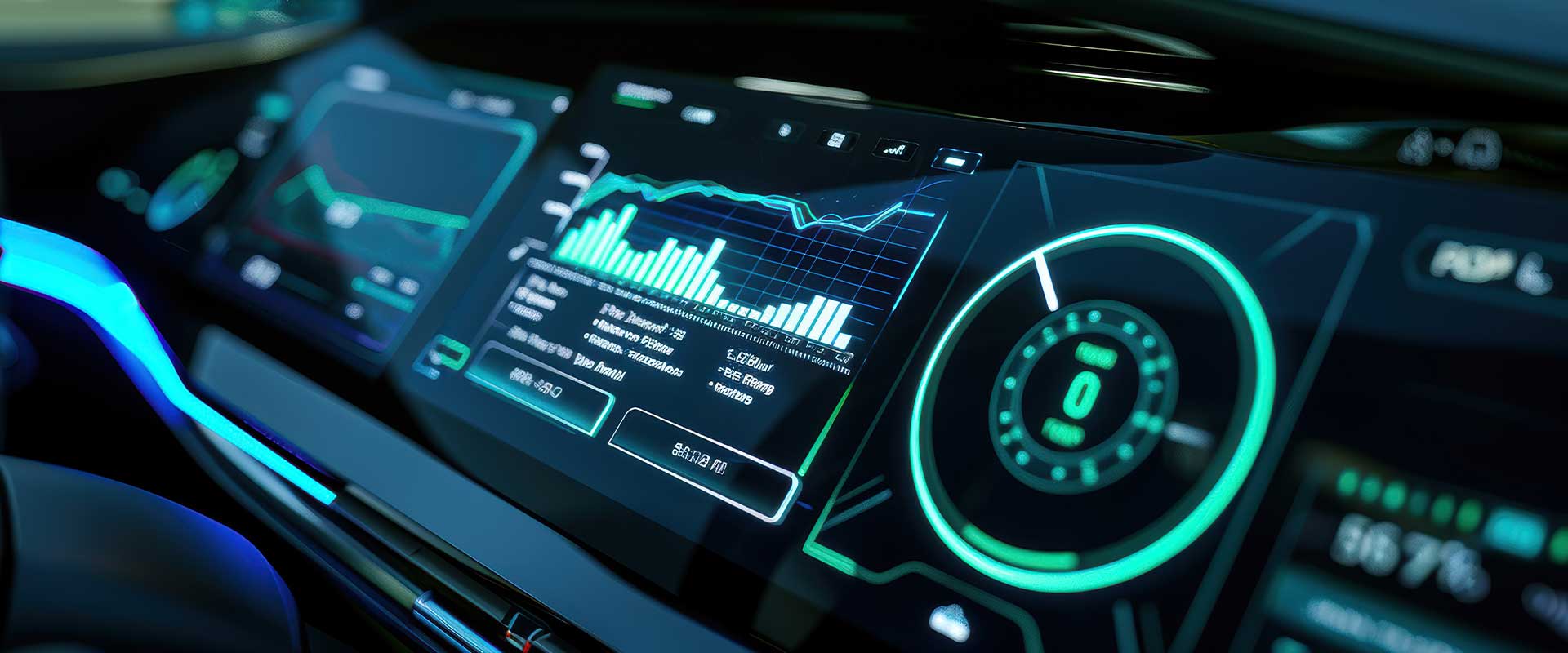
Introduction
In the heart of modern vehicles, a revolution is unfolding. The traditional dashboard, once a simple array of gauges and controls, has transformed into a sophisticated digital environment that rivals the complexity of an aircraft cockpit. This evolution of the automotive digital cockpit represents a rapid shift in how drivers interact with their vehicles. However, as these interfaces become increasingly advanced, a critical question emerges: Are we approaching a tipping point where the pursuit of technological sophistication may compromise the fundamental user experience of driving?
This article explores the world of automotive digital cockpits, exploring their rapid evolution, current state, and potential future trajectories. As we navigate this complex landscape, we will consider how cultural factors and the progress of autonomous driving technology influence digital cockpit design and explore whether a shift towards minimalism could represent the next frontier in automotive innovation.
The digital cockpit revolution: From analog to AI
The transformation of vehicle interiors from analog simplicity to digital complexity has been rapid and profound. Let’s trace this evolution through distinct phases:

Today’s cutting-edge digital cockpit incorporates a range of sophisticated technologies:
- Pillar to Pillar Displays: Seamless screens spanning the entire dashboard, capable of displaying a wealth of information and offering customizable interfaces.
- Multi-screen Setups: Separate displays for instrument clusters, infotainment, climate control, and passenger entertainment, creating a immersive digital environment.
- Driver Monitoring Systems (DMS): Advanced cameras and sensors that track driver alertness, eye movement, and posture to enhance safety and customize the driving experience.
- Haptic Feedback Systems: Touch-sensitive surfaces with tactile response, aiming to replicate the feel of physical buttons while maintaining a sleek, digital aesthetic.
- Gesture Control: Cameras and sensors that interpret hand movements to control various vehicle functions without physical contact, reducing visual clutter in the cockpit.
AI Integration in Digital Cockpit
Artificial Intelligence has become a cornerstone of modern digital cockpit design, manifesting in several key areas:
- Virtual Assistants: AI-powered voice recognition systems capable of natural language processing, controlling vehicle functions, providing information, and even engaging in simple conversations.
- Predictive Interfaces: AI algorithms that learn driver preferences and habits, preemptively adjusting settings like climate control, seat position, and music selection based on patterns and contextual data.
- Adaptive Displays: Interfaces that dynamically adjust based on driving conditions, user preferences, and contextual factors, prioritizing relevant information and reducing cognitive load.
- Advanced Driver Assistance Systems (ADAS) Integration: Seamless incorporation of AI-powered safety features into the digital cockpit, providing real-time feedback and alerts.
- Emotional and Physiological Sensing: Systems that attempt to gauge occupant mood and physical state, adjusting vehicle parameters and interface presentations accordingly.
The Technological Arms Race Intruding Digital Cockpit
The rapid advancement of digital cockpit technology has brought significant benefits:
- Enhanced Safety: Features like collision avoidance warnings and driver alertness monitoring are integrated directly into the driver’s field of view.
- Improved Navigation: Real-time traffic updates, augmented reality overlays, and integration with smart city infrastructure enhance route planning and guidance.
- Seamless Connectivity: Integration with smartphones and smart home devices creates a continuous digital experience from home to vehicle.
- Personalization: AI-driven systems can tailor the driving experience to individual preferences and needs, creating a more comfortable and efficient journey.
However, this technological abundance in digital cockpit also presents several challenges:
- Cognitive Overload: The sheer volume of information and options available can overwhelm drivers’ cognitive capacities, potentially leading to decreased attention on the road.
- Driver Distraction: Complex interfaces and feature-rich systems may divert drivers’ attention from the primary task of safe vehicle operation. Studies have shown that even brief glances away from the road significantly increase accident risk.
- Learning Curve: As digital cockpit become more sophisticated, drivers may require more time to familiarize themselves with new interfaces, potentially leading to frustration or underutilization of features.
- Privacy Concerns: The extensive data collection required for personalized and predictive interfaces raises questions about data privacy and security.
- Reliability and Maintenance Complexity: Sophisticated electronic systems can be prone to software glitches and often require specialized (and costly) maintenance.
- Cybersecurity Risks: The increasing connectivity of digital cockpit exposes vehicles to potential cyberattacks, which could compromise both safety and privacy.
The Impact of Autonomous Driving Progress on Digital Cockpit Design
The current state of autonomous driving technology significantly influences digital cockpit design. While the industry initially raced towards fully autonomous vehicles (Level 5 automation), recent challenges have led many manufacturers to limit to Level 2+ automation systems. This shift has important implications for digital cockpit interfaces:
- Driver Engagement: With Level 2+ systems, the driver must remain engaged and ready to take control. The digital cockpit must maintain driver awareness and facilitate smooth transitions between automated and manual control.
- Information Prioritization: Interfaces must clearly communicate the current state of automated systems and any required driver actions without overwhelming the user with unnecessary data.
- Trust Calibration: The digital cockpit plays a crucial role in building appropriate levels of trust in automated systems. Interfaces must accurately convey system capabilities and limitations to prevent overreliance on automation.
- Adaptive Complexity: As vehicles transition between different levels of automation (e.g., from highway to city driving), the digital cockpit may need to adapt dynamically, presenting more or less information as appropriate.
The Case for Minimalism in Digital Cockpit Design
As digital cockpit become increasingly complex, a countermovement advocating for minimalism in design is gaining traction. This approach emphasizes:
- Reduced Cognitive Load: Streamlining interfaces to allow drivers to focus more on the road and less on navigating complex menus.
- Essential Information Display: Prioritizing critical data while allowing easy access to secondary functions when needed.
- Intuitive Controls: Emphasizing natural gestures, voice commands, and simplified touch interfaces over complex menu structures.
- Adaptive Interfaces: Displaying information contextually based on driving conditions and user preferences.
- Aesthetic Simplicity: Creating a sense of calm and focus within the vehicle interior through clean, uncluttered design.
- Neuromorphic Interfaces: Incorporating principles of neuromorphic UX design to create more intuitive and adaptive user interfaces that mimic the brain’s information processing. Neuromorphic design enables more efficient parallel processing of multiple inputs, aligning with the complex, multi-tasking nature of driving.
- Bio-Inspired Computing: Leveraging neuromorphic principles to develop systems that better integrate with human cognition, potentially leading to more natural and less distracting interactions within the digital cockpit. These interfaces can adapt to individual user behaviors and preferences over time, reducing cognitive load.
Implementing a minimalist digital cockpit presents its own set of technical challenges:
- Information Prioritization Algorithms: Developing sophisticated systems to determine what information is most relevant in any given driving scenario.
- Adaptive Display Technologies: Creating screens that can adjust not just brightness and contrast but also information density and layout in real-time.
- Advanced Haptics: Developing touch surfaces that can provide tactile feedback mimicking physical controls without adding visual clutter.
- Natural Language Processing: Refining voice control systems to handle a wide range of accents and languages with high accuracy.
- Neuromorphic Hardware Integration: Developing and integrating neuromorphic chips that can efficiently process sensory inputs and adapt to user behavior in real time, supporting more intuitive and responsive interfaces.
Balancing Innovation and Usability in Digital Cockpit
The evolution of the automotive digital cockpit represents one of the most dynamic and challenging areas of vehicle design. As we progress through this transformative period, the industry faces the complex task of balancing technological innovation with usability, safety, and driver satisfaction.
As cultural considerations, autonomous driving capabilities, and user preferences continue to shape the development of digital cockpits, manufacturers have a unique opportunity to redefine the driving experience. The most successful designs will likely be those that seamlessly blend advanced technology with intuitive usability, creating digital environments that enhance rather than complicate the joy of driving.
In navigating this balance, the automotive industry stands at the threshold of a new era in human-machine interaction, where the digital cockpit becomes not just a control center, but an intelligent, adaptive companion for the journey ahead.










